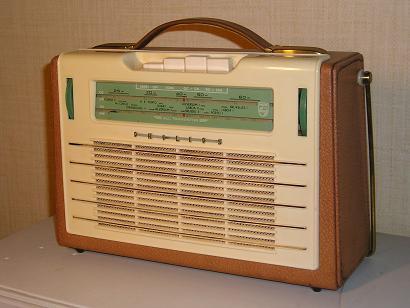L3LN78T/10
Philips Portugal
- Country
- Portugal
- Manufacturer / Brand
- Philips Portugal
- Year
- 1957/1958 ?
- Category
- Broadcast Receiver - or past WW2 Tuner
- Radiomuseum.org ID
- 73929
-
- Brand: FAPAE
- Number of Transistors
- 8
- Main principle
- Superheterodyne (common); ZF/IF 452 kHz
- Wave bands
- Broadcast and Short Wave (SW).
- Power type and voltage
- Dry Batteries / 9 Volt
- Loudspeaker
- Permanent Magnet Dynamic (PDyn) Loudspeaker (moving coil) - elliptical
- Power out
- 3 W (unknown quality)
- Material
- Leather / canvas / plastic - over other material
- from Radiomuseum.org
- Model: L3LN78T/10 - Philips Portugal
- Shape
- Portable set > 8 inch (also usable without mains)
- Dimensions (WHD)
- 265 x 175 x 85 mm / 10.4 x 6.9 x 3.3 inch
- Net weight (2.2 lb = 1 kg)
- 2.2 kg / 4 lb 13.5 oz (4.846 lb)
- Author
- Model page created by Mario Coelho. See "Data change" for further contributors.
- Other Models
-
Here you find 77 models, 71 with images and 31 with schematics for wireless sets etc. In French: TSF for Télégraphie sans fil.
All listed radios etc. from Philips Portugal
Forum contributions about this model: Philips Portugal: L3LN78T/10
Threads: 1 | Posts: 1
Dear Radio Friends
I herd that Philips L3X7_T models were the first transistored models from Philips.
Do you have the same opinion ?
I've one: L3 LN 78T/10.

This model has some differencies from the others: L3X71T and L3X72T
It has:
8 transistores (the first one is a OC170)
Dial Glass is written in Portuguese
Short wave instead of Long wave
In Brazil was made one similar: The L3 R 78T
year 1960 (guess)
Can you help with any information plus about?
Best Regards
Mário
I herd that Philips L3X7_T models were the first transistored models from Philips.
Do you have the same opinion ?
I've one: L3 LN 78T/10.
This model has some differencies from the others: L3X71T and L3X72T
It has:
8 transistores (the first one is a OC170)
Dial Glass is written in Portuguese
Short wave instead of Long wave
In Brazil was made one similar: The L3 R 78T
year 1960 (guess)
Can you help with any information plus about?
Best Regards
Mário
Mario Coelho, 19.Oct.04
